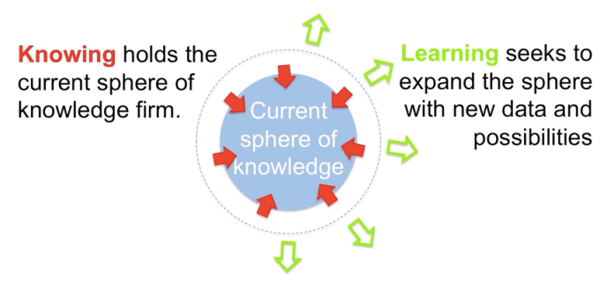
Knowing vs. Learning
Organizational Leadership & Change Management
Last month I was privileged to be one of 175 leaders selected to attend the inspiring Culture Conference in Santa Clara, CA. There were so many brilliant thinkers and ideas at this event that it will likely provide fodder for many future blog posts.
This dispatch focuses on one of my favorite frameworks from the conference. The concept of “knowing vs. learning” was presented by Tom Chi, Founder of Prototype Thinking and former leader at Google X and The Factor. Tom has worked with hundreds of companies to help design and launch products. Through this work he’s discovered an important insight. A brain in knowing mode is distinctly different from a brain in learning mode. As Tom has described, “When you’re in knowing mode, it shuts down the capability of your brain to form new learning memories. When you’re knowing you are trying to hold tight to your current sphere of knowledge. When you’re learning, you are seeking to expand your sphere with new data and possibilities.” As much as we like like to think we can both know and learn at the same time, we simply cannot. As Tom has explained, “It’s hard to do any two verbs at the same time [think playing the violin and riding a bicycle]. It’s even harder to be knowing and learning at the same time.” And yet, we very often conflate our experience of knowing and learning.
Tom’s presentation reminded me of the core principles of New School Rule #6: Schools Grow When People Grow. Like Tom, Anthony Kim and Alexis Gonzales-Black (authors of The New School Rules), talk about the importance of creating a culture of learning.
Real Life: Noticing My ModeI think of myself as a multi-tasking, ambidextrous person who can easily toggle between strategy and tactics. Prior to Tom’s talk, I hadn’t given much thought to when my brain was in a learning vs. knowing mode. These two functions seemed like one in the same, or at least easy to toggle between. Tom’s presentation dramatically changed how I thought about my own mode operating.
Last week, I was meeting with three other leaders at our organization, reviewing the agenda for an upcoming all hands meeting. I went into the meeting expecting to confirm a plan for sharing our company’s state of the union. I quickly discovered through our discussion that my colleagues had powerful new ideas for how we structure the presentation. With Tom’s framing in mind, I tried to shift from a stance of knowing to one of learning by asking questions instead of making statements. What else might we learn from this? What other ways might we structure our session? What other goals might we have for the presentation?
Having the knowing vs. learning framework, won’t always mean I am able switch to a learning stance. But it will help me (and I hope you too) notice which mode I, and others in the meeting, are operating in. This can be powerful in making a shift and opening up our current spheres of knowledge.
Visualize: Knowing Makes Your Learning Impossible
Image credit: Tom Chi
Use It: Notice and shiftStart with yourself. Notice when you’re in a knowing vs. learning mode in conversations. Once you’ve developed an awareness, try shifting your stance from knowing to learning by asking yourself questions like “what else might be learned about this?” You might start to notice when others are in a knowing mode and engage them with questions to shift their mode to learning as well.
If you want to explore more about knowing vs. learning, check out Tom’s TedX video on this topic or join me in conversation at @kearaduggan.
This blog post was originally published on The KikiBrief.
About Keara Mascareñaz
Keara is a Managing Partner at Education Elements who focuses on how to build and scale a culture of innovation in large systems, how to create national communities of collaboration, and how to keep laughing when pursuing daunting, large-scale changes. She was lucky to collaborate with co-authors Alexis Gonzales-Black and Anthony Kim to design the website and toolkit for The NEW School Rules: 6 Practices for Responsive and Thriving Schools.




